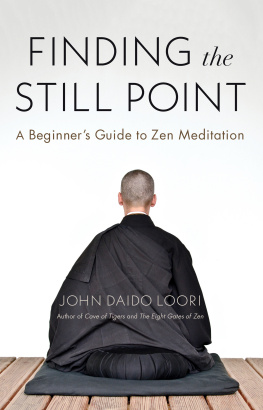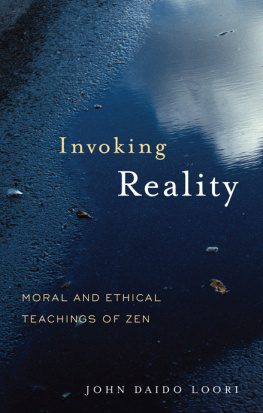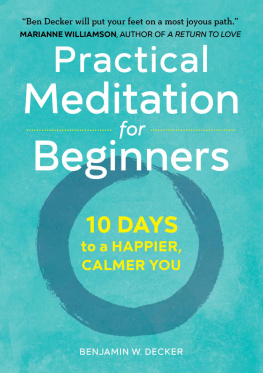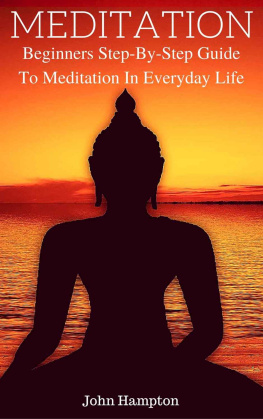John Daido Loori - A Beginners Guide to Zen Meditation
Here you can read online John Daido Loori - A Beginners Guide to Zen Meditation full text of the book (entire story) in english for free. Download pdf and epub, get meaning, cover and reviews about this ebook. year: 2020, publisher: Shambhala, genre: Religion. Description of the work, (preface) as well as reviews are available. Best literature library LitArk.com created for fans of good reading and offers a wide selection of genres:
Romance novel
Science fiction
Adventure
Detective
Science
History
Home and family
Prose
Art
Politics
Computer
Non-fiction
Religion
Business
Children
Humor
Choose a favorite category and find really read worthwhile books. Enjoy immersion in the world of imagination, feel the emotions of the characters or learn something new for yourself, make an fascinating discovery.
- Book:A Beginners Guide to Zen Meditation
- Author:
- Publisher:Shambhala
- Genre:
- Year:2020
- Rating:4 / 5
- Favourites:Add to favourites
- Your mark:
- 80
- 1
- 2
- 3
- 4
- 5
A Beginners Guide to Zen Meditation: summary, description and annotation
We offer to read an annotation, description, summary or preface (depends on what the author of the book "A Beginners Guide to Zen Meditation" wrote himself). If you haven't found the necessary information about the book — write in the comments, we will try to find it.
A Beginners Guide to Zen Meditation — read online for free the complete book (whole text) full work
Below is the text of the book, divided by pages. System saving the place of the last page read, allows you to conveniently read the book "A Beginners Guide to Zen Meditation" online for free, without having to search again every time where you left off. Put a bookmark, and you can go to the page where you finished reading at any time.
Font size:
Interval:
Bookmark:


by John Daido Loori
Cave of Tigers
Modern Zen Encounters
Celebrating Everyday Life
Zen Home Liturgy
Hearing with the Eye
Photographs from Point Lobos
Invoking Reality
Moral and Ethical Teachings of Zen
Making Love with Light
Contemplating Nature with Words and Photographs
Mountain Record of Zen Talks
Finding the Still Point
A Beginners Guide to Zen Meditation
Teachings of the Earth
Zen and the Environment
Two Arrows Meeting in Mid-Air
The Zen Koan

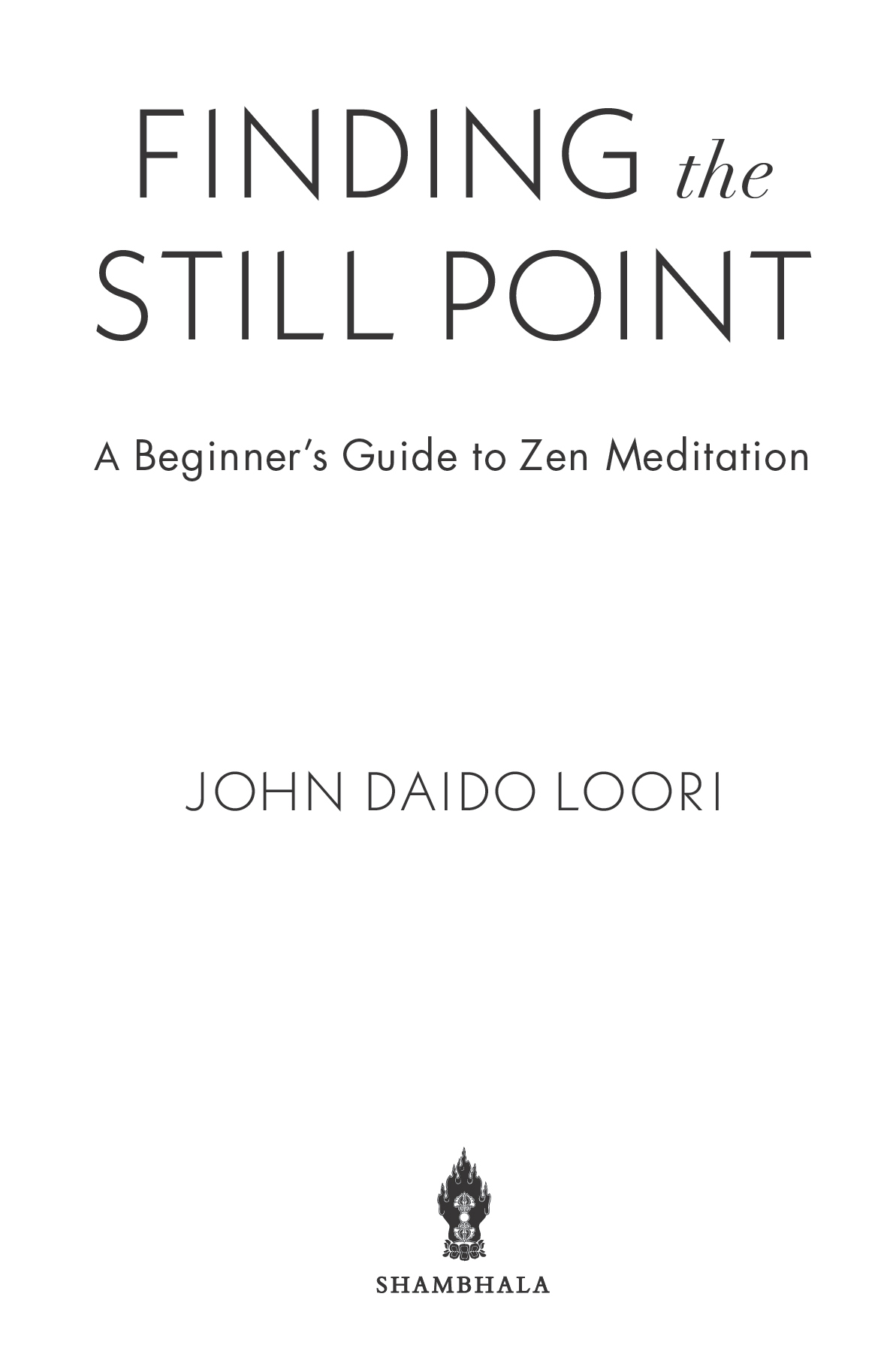
Shambhala Publications, Inc.
4720 Walnut Street
Boulder, Colorado 80301
www.shambhala.com
1996, 2007 by Dharma Communications.
This is a revised and updated edition of a book
previously published in 1996 under the title The Still Point.
The Great Way chapter is excerpted from
Mountain Record of Zen Talks 1988 by
Dharma Communications.
This edition published 2020.
Cover photo: David Gabriel Fischer
Cover design: Daniel Urban-Brown
Interior design: Lora Zorian
All rights reserved. No part of this book may be reproduced in any form or by any means, electronic or mechanical, including photocopying, recording, or by any information storage and retrieval system, without permission in writing from the publisher.
The Library of Congress catalogues the previous edition of this book as follows:
Loori, John Daido.
Finding the Still Point: a beginners guide to
Zen meditation/John Daido Loori.
p. cm.
Originally published: The still point. Boston:
Dharma Communications, 1996.
Includes bibliographical references.
ISBN 978-1-59030-479-2 (hardcover)
ISBN 978-1-61180-845-2 (paperback)
eISBN 9780834842847
1. MeditationZen Buddhism. I. Loori, John Daido.
The still point. II. Title.
bq9288.l663 2007
294.34435dc22
2006051276
for Library of Congress Cataloging-in-Publication Data
a_prh_5.5.0_c0_r0
The Practice of Zen Meditation
A Dharma Discourse
The Practice of Zen Meditation

There are many schools of Buddhism and a vast array of teachings on how to realize our true nature. Some schools focus on the rules of conduct. Others concentrate on academic study and debate. Still others use visualizations and chanting of sacred sounds and words. In Zen, the emphasis is on zazen, or sitting Zen. Zazen is the heart of the Zen path.
To practice zazen is to study the self. In its early stages, zazen has the appearance of what is normally called meditation. But we should understand that zazen is more than just meditation. It is not mere contemplation or introspection. It is not quieting the mind or focusing the mind. Zazen is sitting Zenone aspect of Zen. There is also walking Zen, working Zen, laughing Zen, and crying Zen. Zen is a way of using ones mind and living ones life, and doing this with other people. No rule book has ever been written that can adequately describe Zen. You have to go very deep into yourself to find its foundations.
The great Zen master Eihei Dogen said,
To study the Buddha Way is to study the self,
To study the self is to forget the self,
To forget the self is to be enlightened by the ten thousand things.
To study the self is zazen. To forget the self is zazen. To be enlightened by the ten thousand things is zazenit is to recognize the unity of the self and the whole phenomenal universe.
The Buddha attained enlightenment while practicing a form of seated meditation. Zen practice constantly returns to that basic seated form. This practice has continued for twenty-five hundred years, transmitted from realized practitioner to realized practitioner, from generation to generation. It traveled from India to China, from China to Korea and Japan, and in the twentieth century it arrived in the West.
Zazen is a very simple practice. It is very easy to describe and very easy to follow. But like all practices, it takes doing in order for anything to happen. And what happens with zazen can transform our lives.
Most of us spend our time preoccupied. We are constantly carrying on an internal dialogue. While we are involved in talking to ourselves, we miss the moment-to-moment awareness of our life. We look, but we dont see. We listen, but we dont hear. We eat, but we dont taste. We love, but we dont feel. The senses are receiving all the information, but because of our preoccupations, cognition is not taking place. Zazen brings us back to each moment. The moment is where our life takes place. If we miss the moment, we miss our life.
Every other creature on the face of the earth seems to know how to be quiet and still. A butterfly on a leaf; a cat in front of a fireplace; even a hummingbird comes to rest sometime. But humans are constantly on the go. We seem to have lost the ability to just be quiet, to simply be present in the stillness that is the foundation of our lives. Yet if we never get in touch with that stillness, we never fully experience our lives.
When the mind is at rest, the body is at restrespiration, heartbeat, and metabolism slow down. Reaching this still point is not something unusual or esoteric. It is a very important part of being alive and staying awake. All creatures on the earth are capable of manifesting this stillness.
In zazen, as you practice letting go of your thoughts and internal dialogue, and bringing your mind back to the breath, the breath will slowly get easier and deeper, and the mind will naturally rest. The mind is like the surface of a pond. When the wind blows, the surface is disturbed. Then there are waves and ripples, and the image of the sun or the moon or whatever the surface is reflecting is broken up.
When the wind quiets down, the surface of the pond becomes like glass. The stilled mind is like a mirror. It doesnt process, it just reflects. When there is a flower in front of it, it reflects a flower. When the flower is gone, the reflection is gone. When a fire engine goes by, we hear the fire engine. When the fire engine is gone, its reflection is gone. The mind returns to that original smooth surface. A still mind is unobstructedalways open and receptive. It doesnt hold on or attach to anything. At any moment in time, it is free.
In starting the practice of zazen, the first thing you need to do is find a correct sitting position for the body. Your posture greatly influences what happens with your breath and your mind, so it is important to pay meticulous attention to how you position yourself for zazen. During the twenty-five-hundred-year evolution of Buddhism, the most stable and powerful position found for the practice of zazen has been the pyramidal structure of the seated Buddha.
Font size:
Interval:
Bookmark:
Similar books «A Beginners Guide to Zen Meditation»
Look at similar books to A Beginners Guide to Zen Meditation. We have selected literature similar in name and meaning in the hope of providing readers with more options to find new, interesting, not yet read works.
Discussion, reviews of the book A Beginners Guide to Zen Meditation and just readers' own opinions. Leave your comments, write what you think about the work, its meaning or the main characters. Specify what exactly you liked and what you didn't like, and why you think so.

